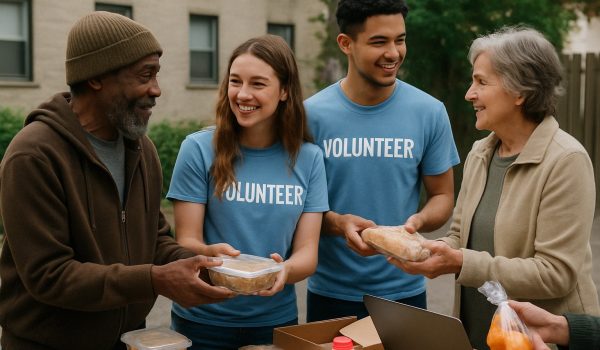In times of crisis, people often look to each other before anything else. That instinct to care for neighbors, support friends, and uplift strangers is what mutual aid is all about. It’s a way of helping that doesn’t wait for official systems to respond. It’s immediate, personal, and rooted in trust.
For communities under pressure—whether from occupation, economic hardship, or displacement—mutual aid offers more than supplies. It builds relationships. It reminds people they are not alone. And it creates networks that can respond quickly to changing needs.
In Palestine and other regions facing ongoing injustice, mutual aid is not just an emergency tool. It is a core part of how people survive, resist, and rebuild. It keeps communities strong by making care a shared responsibility rather than an individual burden.
What Mutual Aid Means for Community Resilience
At its heart, mutual aid is people taking care of each other without waiting for permission. It can be as simple as sharing food or as complex as organizing medical support across neighborhoods. The idea is not charity—it’s solidarity. The goal is not to fix others but to support one another as equals.
Mutual aid stands out because it works from the ground up. People involved know their neighbors’ needs and respond quickly. There are no long approval processes. Instead, trust, listening, and cooperation guide the way. This approach builds long-term relationships between community members, not one-time transactions.
In Palestine, mutual aid has played a key role during lockdowns, curfews, and violent escalations. From families sharing what little they have to grassroots networks organizing emergency deliveries, the spirit of mutual support has helped communities make it through some of the most difficult moments.
Mutual Aid in Practice
During emergencies, mutual aid efforts often begin with a question: Who needs help, and what do they need most? The answer might be food, medicine, housing, or even emotional support. Once that’s clear, people find ways to meet those needs by pooling what they have.
This kind of response does not require large budgets. It runs on care, creativity, and community connections. Local volunteers, students, families, and elders work together. WhatsApp groups, neighborhood walks, and word of mouth become the channels for action.
Mutual aid also adapts. If water becomes scarce, networks focus on that. If schools close, they find ways to share books or host small learning spaces. And because the people involved live the same struggles, they don’t need to guess what’s needed. They already know.
In places under occupation, where access to resources is limited and state services are unreliable or politicized, mutual aid becomes a way to fill the gaps. It creates new routes for survival that don’t depend on outside control.
Building Trust and Ownership
One of the most powerful things about mutual aid is that it creates a sense of shared ownership. When someone gives and receives support within the same network, it reinforces the idea that everyone matters. No one is just a recipient. Everyone has something to offer.
This breaks the usual dynamic of top-down help. Instead of one side giving and the other side taking, people work together as equals. This shift is deeply empowering, especially for those who are used to being overlooked or denied a voice in decisions.
Mutual aid groups often grow into longer-term projects. What starts as food distribution may evolve into a community garden. A group helping with rent today may later organize around housing rights. These efforts don’t just respond to crises—they build the foundation for future stability and justice.
The Challenges of Sustaining Mutual Aid
While mutual aid is powerful, it’s not easy. Volunteers often carry a heavy emotional load. They see suffering up close and feel pressure to do more with limited resources. Burnout can happen, especially when crises last a long time and support from larger institutions is missing.
There’s also the risk of surveillance or restriction, especially in places where organizing is seen as a threat. Mutual aid efforts sometimes operate quietly to protect those involved. They rely on trust, not headlines, to stay safe and effective.
To keep going, mutual aid needs ongoing support—not just in emergencies, but as a constant part of community life. That means training, shared knowledge, and resources that can be used over time. It also means respecting the work of those on the ground and recognizing their leadership.
Mutual Aid and Global Solidarity
Palestinians have long shown what mutual aid can look like under occupation. Their networks have inspired similar efforts in other parts of the world. At the same time, international allies can play a role by supporting these local systems without taking them over.
Support can come in many forms. Sharing funds, amplifying voices, or offering technical tools are all ways to stand in solidarity. But it’s important to follow the lead of those doing the work. Mutual aid is most effective when it remains rooted in the realities and rhythms of the people it serves.
By uplifting mutual aid efforts, global supporters help make space for more sustainable, people-centered responses to injustice. This helps communities not only survive but shape their futures with dignity and strength.
A Path Forward Rooted in Community
Mutual aid is not a new idea. It has existed for generations in many cultures. But today, it offers a clear path for building solidarity that is responsive, respectful, and deeply human.
In restricted, occupied, or underserved areas, mutual aid fills the spaces left by absent or harmful systems. It turns shared hardship into collective action. And it reminds us that care is not a luxury—it’s a form of resistance, a form of healing, and a form of hope.
Whether through a home-cooked meal, a shared ride, or an organized campaign, mutual aid brings people together. It shows that even in the face of hardship, we can build something stronger by standing with each other.

